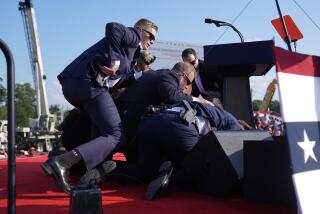There’s a Big Cover-Up at the White House, and the Whitewash Is Sure to Follow
- Share via
WASHINGTON — People are asking: Just what is going on under deep cover at the White House? What new secret is being concealed? What heinous deed is afoot? Is the White House hiding its face in shame? What, for heaven’s sake, is the Reagan Administration up to now?
Great portions of the north facade on either side of the portico are heavily veiled with a fiber-reinforced plastic protective cloth, shielding an elaborate scaffolding.
The historic glass on the windows is covered on the outside and, says Gary Walters, the White House chief usher, the shades are pulled on the inside. In its turn, a third of the south side also will be veiled.
Though William Seale, the biographer of the White House itself, has observed that it looks as though someone wrapped it as a work of art, the wrapper in this case is actually the National Park Service. And the intention is aesthetic only in the long run.
The project began this year, on March 28, just in time for the Easter vacation visitors and it will go on for five months, ruining visitors’ photographs for the entire summer.
But it’s all on the side of good, said Jim McDaniel, National Park Service associate regional director.
“The White House is being stripped of something like 30 coats of paint. We’re taking it down to the bare sandstone,” he says.
Come September, there will be unveiled a sight unseen since 1797, when the White House acquired its name from the whitewash used to seal its porous Aquia Creek sandstone.
“Every four years since World War II, we’d repainted the White House so it would look nice for the inauguration,” says McDaniel. “But in 1976, we found that the paint just wasn’t sticking right. We had to touch it up so often, we ended up painting it all the time.”
So the Park Service went to the National Bureau of Standards’ Center for Building Technology. The center recommended chemical paint removal, instead of sandblasting, which could have gouged the soft sandstone.
The contractor--Ramco Technology of Hartford, Conn.--first power-washes the walls and then uses an acid-based formula.
“We’ve uncovered wonderful ornamentation, rosettes, dentil work--stone carving that had been completely obscured by the paint layers. Now they have lights and shadows,” McDaniel says. “The workmen have to clean by hand around the carving, using nylon brushes and lots of patience. A garland just over the front door--under the portico--is so nice the White House Historical Assn. copied it for their Christmas ornament.”
Vincent Palumbo, the master carver for the Washington Cathedral who was featured in the award-winning documentary “The Stone Carvers,” is restoring damaged stonework.
After stripping, the stone will be left bare to dry out until next spring, when it will be painted. Four years hence, the remaining two-thirds of the south wall and the west wall will be stripped and repainted.
The project began in 1976 with the study. It’s meant to be completed by October, 1992, the 200th anniversary of the White House cornerstone laying.
“We’ve been doing the paint stripping at 4-year intervals,” says McDaniel, “because we couldn’t ask any one presidential family to put up with it for all the summers we needed to do it all.”
In 1980, the east wall was completely stripped and repainted. The North Portico was done in 1984. So far, the Park Service has been pleased with the results. “The east wall looks fine. After eight years, all we had to do was wash it,” McDaniel says.
More to Read
Sign up for The Wild
We’ll help you find the best places to hike, bike and run, as well as the perfect silent spots for meditation and yoga.
You may occasionally receive promotional content from the Los Angeles Times.






